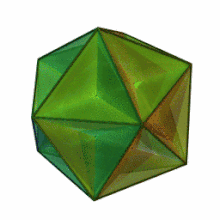Great dodecahedron
| Great dodecahedron | |
|---|---|
 | |
| Type | Kepler–Poinsot polyhedron |
| Faces | 12 |
| Edges | 30 |
| Vertices | 12 |
| Symmetry group | icosahedral symmetry |
| Dual polyhedron | small stellated dodecahedron |
| Properties | regular, non-convex |
| Vertex figure | |
 | |

In geometry, the great dodecahedron is one of four Kepler–Poinsot polyhedrons. It is composed of 12 pentagonal faces (six pairs of parallel pentagons), intersecting each other making a pentagrammic path, with five pentagons meeting at each vertex.
Construction[edit]
One way to construct a great dodecahedron is by faceting the regular icosahedron. In other words, it is constructed from the regular icosahedron by removing its polygonal faces without changing or creating new vertices. Another way is to form a regular pentagon by each of the five vertices inside of a regular icosahedron, and twelve regular pentagons intersecting each other, making a pentagram as its vertex figure.[1][2]
The great dodecahedron may also be interpreted as the second stellation of dodecahedron. The construction started from a regular dodecahedron by attaching 12 pentagonal pyramids onto each of its faces, known as the first stellation. The second stellation appears when 30 wedges are attached to it.[3]
Formulas[edit]
Given a great dodecahedron with edge length . The circumradius of a great dodecahedron is: Its surface area is: Its volume is:[4]
Related polyhedra[edit]

It shares the same edge arrangement as the convex regular icosahedron; the compound with both is the small complex icosidodecahedron.
If only the visible surface is considered, it has the same topology as a triakis icosahedron with concave pyramids rather than convex ones. The excavated dodecahedron can be seen as the same process applied to a regular dodecahedron, although this result is not regular.
A truncation process applied to the great dodecahedron produces a series of nonconvex uniform polyhedra. Truncating edges down to points produces the dodecadodecahedron as a rectified great dodecahedron. The process completes as a birectification, reducing the original faces down to points, and producing the small stellated dodecahedron.

The compound of small stellated dodecahedron and great dodecahedron is a polyhedron compound where the great dodecahedron is internal to its dual, the small stellated dodecahedron. This can be seen as one of the two three-dimensional equivalents of the compound of two pentagrams ({10/4} "decagram"); this series continues into the fourth dimension as compounds of star 4-polytopes.
Appearance[edit]
The discovery of the great dodecahedron is sometimes credited to Louis Poinsot in 1810, though there is a drawing of something very similar to a great dodecahedron in the 1568 book Perspectiva Corporum Regularium by Wenzel Jamnitzer.
This shape was the basis for the Rubik's Cube-like Alexander's Star puzzle.
The great dodecahedron provides an easy mnemonic for the binary Golay code[5]
See also[edit]
References[edit]
- ^ Pugh, Anthony (1976). Polyhedra: A Visual Approach. University of California Press. p. 85.
- ^ Barnes, John (2012). Gems of Geometry (2nd ed.). Springer. p. 46. doi:10.1007/978-3-642-30964-9. ISBN 978-3-642-30964-9.
- ^ Cromwell, Peter (1997). Polyhedra. Cambridge University Press. p. 265.
- ^ French, Doug; Jordan, David (2010). "Dodecahedral slices and polyhedral pieces". The Mathematical Gazette. 92 (529): 5–17. JSTOR 27821883.
- ^ * Baez, John "Golay code," Visual Insight, December 1, 2015.








